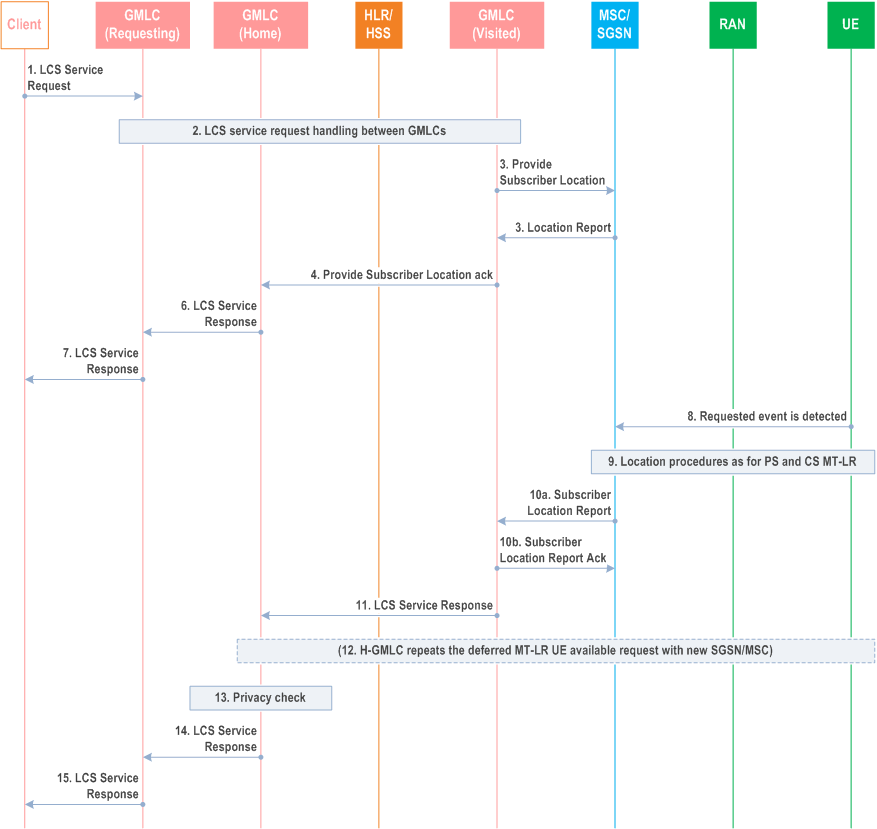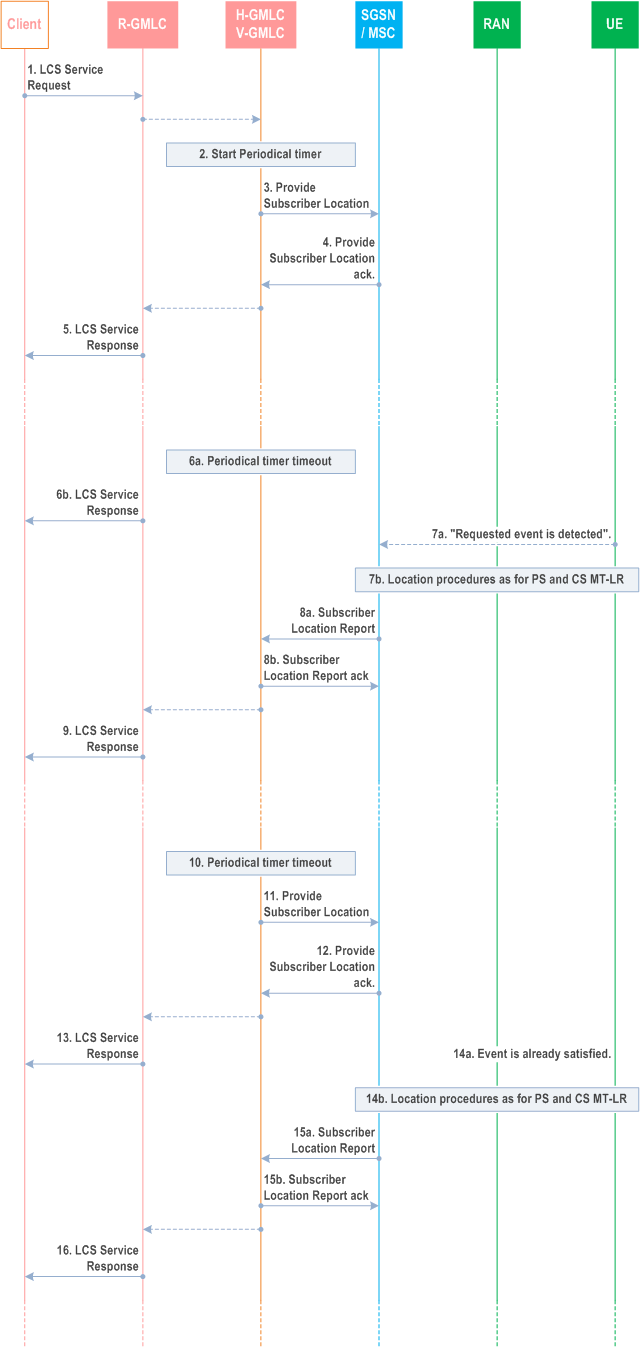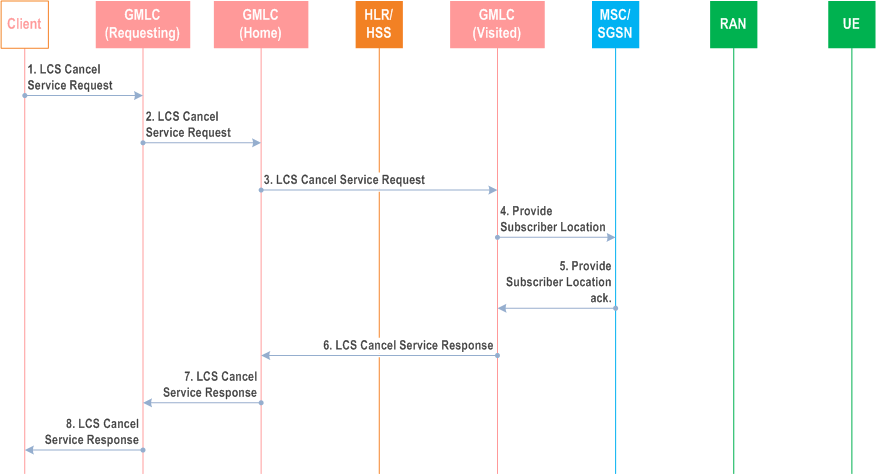Content for TS 23.271 Word version: 18.0.0
1…
5…
6…
6.2…
7…
8…
9…
9.1.1A…
9.1.2…
9.1.5…
9.1.6…
9.1.8…
9.1.9…
9.1.12…
9.1.13…
9.1.15…
9.1.19…
9.2…
9.2.2…
9.2.3…
9.3…
9.4…
9.5…
9.6…
10…
11…
A…
B…
E
F…
9.1.8 Mobile Terminating Deferred Location Request - UE available event
9.1.8.1 Deferred Location Request Procedure
9.1.8.2 Location Report Procedure
9.1.8.3 Combined Periodical/Deferred Mobile Terminating Location Request with UE available event
9.1.8.4 Cancellation of a Deferred Location Request - UE available event
...
...
9.1.8 Mobile Terminating Deferred Location Request - UE available event p. 82
Figure 9.6a illustrates the procedures for a Deferred Location Request, where the Location Report is returned based on a UE available event.

9.1.8.1 Deferred Location Request Procedure p. 82
Step 1.
The LCS Service Request shall contain an indication of the requested event i.e. UE available.
Step 2.
LCS service request handling between GMLCs as described in clause 9.1.1. The information received by the R-GMLC is transferred to the H-GMLC. The H-GMLC assigns a LDR reference number to this LCS Service request and transfers the information to the V-GMLC, including the LDR reference number and the H-GMLC address.
Step 3.
The V-GMLC sends the UE available event to MSC/SGSN in the Provide Subscriber Location request (deferred) and includes the LDR reference number and the H-GMLC address in the request.
Step 4.
If the SGSN/MSC cannot support the deferred location request for the specified event (for temporary or permanent reasons), or if either the security or privacy check related actions fail, then a Provide Subscriber Location return error shall be returned with a suitable cause. If the SGSN/MSC can support the deferred location request for the specified event, a Provide Subscriber Location ack. shall be returned to the V-GMLC without a location estimate. The SGSN/MSC may record charging information for an accepted deferred location request.
Step 5.
V-GMLC returns the LCS Service Response to H-GMLC to notify whether the request was successfully accepted or not. The V-GMLC may record charging information for an accepted deferred location request.
Step 6.
H-GMLC returns the LCS Service Response to R-GMLC to notify whether the request was successfully accepted or not. When the H-GMLC returns the LCS Service Response to the R-GMLC, the LDR reference number assigned by the H-GMLC shall be included. The H-GMLC may record charging information for an accepted deferred location request.
Step 7.
The R-GMLC then returns the LCS Service Response with LDR reference number to the LCS Client to notify whether the request was successfully accepted or not. The R-GMLC may record charging information for an accepted deferred location request.
9.1.8.2 Location Report Procedure p. 83
Step 8.
Immediately following step 3, the SGSN/MSC shall verify if the requested event is already satisfied (e.g. UE available inferred from a current transaction) or can be invoked immediately (e.g. by paging the UE and receiving a page response). If the requested event is not already satisfied, the SGSN/MSC waits until it has occurred or until some maximum time has expired.
In case the SGSN/MSC receives an indication that the UE has moved to another SGSN/MSC, while it is waiting for the requested event to happen, SGSN/MSC shall immediately send a Subscriber Location Report to the V-GMLC. The report shall include the reference number and H-GMLC address that were included in the Provide Subscriber Location request and the information that the MT-LR must be reinitiated against the new SGSN/MSC. It shall also include the address of the new SGSN/MSC, if available. If the V-GMLC is associated with the new MSC/SGSN, it re-issues the location request to the new MSC/SGSN. Otherwise the V-GMLC forwards the responses to the H-GMLC. If the H-GMLC already knows (e.g. from a previous location request or an internal lookup table), or is able to determine, (e.g. it is possible to use a DNS lookup mechanism similar to IETF RFC 2916), the network address of the V-GMLC, it reinitiates the MT-LR to the new SGSN/MSC through the new V-GMLC. Otherwise, the H-GMLC shall then issue a SEND_ROUTING_INFO_FOR_LCS message to get the address of the V-GMLC associated with the new SGSN/MSC and reinitiate the MT-LR with the new SGSN/MSC through the new V-GMLC, see step 12.
Step 9.
When the requested event is detected, the SGSN/MSC shall proceed with the location request as described in clauses 9.1.2 / 9.1.6. If an LCS Location Notification Invoke message is sent to the target UE as defined in step 4 of clause 9.1.2.1 and step 5 of clause 9.1.6.1, the type of location request shall indicate current location and the deferred location event type shall be omitted.
If either security or privacy check related actions fail, the SGSN/MSC shall send a Subscriber Location Report with the reference number and H-GMLC address that was included in the Provide Subscriber Location with appropriate error cause indicating termination of the deferred location request.
Step 10.
When location information has been obtained from the RAN, the SGSN/MSC returns the Subscriber Location Report. The report shall include the reference number that was included in the Provide Subscriber Location, the H-GMLC address, an indication that this is a response to a previously sent deferred location request and may also include the indication whether the obtained location estimate satisfies the requested accuracy or not (provided that this indication is obtained from RAN with the location estimate). The SGSN/MSC may record charging information.
If the location information could not be obtained, or the SGSN/MSC for some other reason decides to not wait any longer for the requested event to occur (ex. timer expires), the Subscriber Location Report with the reference number and H-GMLC address that was included in the Provide Subscriber Location will be returned with an appropriate error cause indicating termination of the deferred location request.
Step 11.
V-GMLC sends the LCS Service Response to the H-GMLC with an indication of the event occurrence and the LDR reference number. The LCS Service Response is sent in accordance with the requested QoS Class, as described in clause 9.1.1 for common MT-LR.
Step 12.
In case the LCS Service Response indicates to H-GMLC that the mobile has moved to another SGSN/MSC, the H-GMLC shall send the deferred MT-LR with UE available event to the V-GMLC (previous or new), which forwards the request to the new SGSN/MSC, as described in step 2 onwards.
Step 13.
The H-GMLC performs the privacy check as described in clause 9.1.1.
Step 14.
The H-GMLC sends the LCS Service Response to R-GMLC. When the H-GMLC returns the LCS Service Response to the R-GMLC, the LDR reference number that was sent to the R-GMLC in step 6 shall be included.
Step 15.
The R-GMLC sends the LCS Service Response with the LDR reference number to the LCS Client.
9.1.8.3 Combined Periodical/Deferred Mobile Terminating Location Request with UE available event p. 84
Figure 9.6b illustrates the procedures for a Combined Periodical/Deferred Mobile Terminating Location Request with UE available event, where the response to the LCS client is returned periodically and based on the event. This clause is applicable only to the case, when the R GMLC handles the periodicity of the location requests. The case when the UE handles the periodicity of location reporting, as specified in clause 9.1.12, is independent of this clause.

Step 1.
When a R-GMLC receives a LCS Service Request from a LCS client, the R-GMLC verifies the identity of the LCS client as described in clause 9.1.1, then the R-GMLC transfers the periodical request to the H-GMLC.
Step 2.
The H-GMLC starts the periodical timer and assigns a LDR reference number for this periodical request, and initiates the common LCS procedures as described in clause 9.1.1.
Step 3.
The V-GMLC sends a Deferred Location Request to the SGSN/MSC by means of Provide Subscriber Location as described in clauses 9.1.2 / 9.1.6. In addition, the Deferred Location Request includes the reference number assigned by the H-GMLC and the event that shall trigger the sending of Subscriber Location Report.
Step 4.
If the SGSN/MSC cannot support the deferred location request for the specified event or the LCS client is not allowed to position the requested UE according to subscription information, a Provide Subscriber Location error is returned to the V-GMLC. If the SGSN/MSC can support the deferred location request for the specified event and the privacy checks are satisfied, a Provide Subscriber Location ack shall be returned to the V-GMLC without a location estimate. The SGSN/MSC may record charging information for an accepted deferred location request.
Step 5.
The V-GMLC then returns the LCS Service Response to the LCS Client via H-GMLC and R-GMLC to notify whether the request was successfully accepted or not. The V-GMLC, H-GMLC and R-GMLC may record charging information for an accepted deferred location request. When the H-GMLC returns the LCS Service Response to the LCS Client via R-GMLC, the LDR reference number assigned by the H-GMLC shall be included.
Step 6.
When the periodical timer expires, if the H-GMLC is still waiting for the event, the H-GMLC shall send a LCS Service Response to the LCS client via R-GMLC, indicating that the location is not available at that moment. The LDR reference number that was sent to the LCS Client in step 5 shall be included in the response.
Step 7.
When the requested event is detected, the SGSN/MSC will proceed with the location request as described in clauses 9.1.2 / 9.1.6. If an LCS Location Notification Invoke message is sent to the target UE as defined in step 4 of clause 9.1.2.1 and step 5 of clause 9.1.6.1, the type of location request shall indicate current location and the deferred location event type shall be omitted.
Step 8.
When location information has been obtained from the RAN, the SGSN/MSC returns the Subscriber Location Report. The report shall include the reference number included in the previously sent Provide Subscriber Location and an indication that this is a response to a previously sent deferred location request. The SGSN/MSC may record charging information.
If the location information could not be obtained, or the SGSN/MSC for some other reason decides to not wait any longer for the requested event to occur (ex. timer expires), the Subscriber Location Report with the reference number included in the previously sent Provide Subscriber Location will be returned with an appropriate error cause indicating termination of the deferred location request.
Step 9.
The V-GMLC then returns the LCS Service Response to the LCS Client via H-GMLC and R-GMLC as in clauses 9.1.2 / 9.1.6. When the H-GMLC returns the LCS Service Response to the LCS Client via R-GMLC, the LDR reference number that was sent to the LCS Client in step 5 shall be included.
Step 10.
When the timer expires, if the H-GMLC is not waiting for the event, the H-GMLC initiates the common LCS procedures as described in clause 9.1.1. The H-GMLC should use the same LDR reference number assigned in the step 2, should NOT assign a new LDR reference number.
Step 11.
Same as step 3.
Step 12.
Same as step 4.
Step 13.
Same as step 5.
Step 14.
If the requested event is already satisfied, the SGSN/MSC will proceed with the location request as described in clauses 9.1.2 / 9.1.6. If an LCS Location Notification Invoke message is sent to the target UE as defined in step 4 of clause 9.1.2.1 and step 5 of clause 9.1.6.1, the type of location request shall indicate current location and the deferred location event type shall be omitted.
Step 15.
Same as step 8.
Step 16.
Same as step 9.
9.1.8.4 Cancellation of a Deferred Location Request - UE available event |R5| p. 87

Step 1.
The LCS Client requests the cancellation of a previously requested Deferred Location Request. The LDR reference number that was included in the previous LCS Service Response sent by the GMLC shall be included in the request to indicate which outstanding LDR should be cancelled.
Step 2.
The R-GMLC sends the cancellation request to H-GMLC, including the LDR reference number. The cancellation could be initiated by the R-GMLC itself for some reasons (e.g. the expiry of the validity timer specified by the start time and stop time; or the expiry of an implementation dependent timer specified by the Operator as a default value in the R-GMLC when the stop time is undefined or exceeds the maximum allowed value).
Step 3.
The H-GMLC forwards the LCS Cancel Service Request to V-GMLC with the LDR reference number which is received from the R-GMLC, and the H-GMLC address. The H-GMLC may itself initiate the cancellation procedure, e.g. if an implementation dependent timer in the H-GMLC expired, or when the UE's privacy profile stored in the H-GMLC or in the PPR was changed. For every outstanding Deferred Location Request against that UE, the H-GMLC shall perform or ask the PPR to perform a new privacy check based on the updated privacy profile. If the privacy check passes, i.e. the LCS Client is still allowed to position the target UE, the handling of the outstanding Deferred Location Request should be continued. Otherwise, if the privacy check does not pass, i.e. the Location estimate of the target UE is not allowed to be provided to the LCS Client, the H-GMLC shall initiate a cancellation procedure.
Step 4.
The V-GMLC will indicate this cancellation request in the Provide Subscriber Location toward the SGSN/MSC. The Provide Subscriber Location shall include the H-GMLC address, and the reference number specified by LCS Client in the LCS Cancel Service Request.
Step 5.
When the SGSN/MSC completes the cancellation procedure, it notifies it to the V-GMLC in the Provide Subscriber Location Ack (with no location estimate included).
Step 6.
The V-GMLC sends the LCS Cancel Service Response to H-GMLC.
Step 7.
H-GMLC sends the LCS Cancel Service Response to R-GMLC. H-GMLC may send the LCS Cancel Service Response to R-GMLC, even if the R-GMLC/LCS client has not requested the cancellation, see step 3.
Step 8.
The R-GMLC sends the LCS Cancel Service Response to the LCS Client.